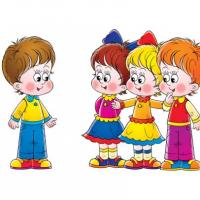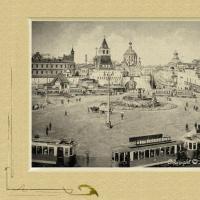Make a simple collage in Photoshop. Create a collage from one or more photos in Photoshop. Collage in Photoshop quickly and easily
Collage is the process of converting multiple photos into a single frame.... He should not be too lazy to choose the most favorite of your pictures and arrange them so that they directly complement the overall picture with the clearest transfer of history and emotions.
The photo collage will be saved both for your friends and for yourself as a reminder of good impressions.
To make a collage, you need Photoshop from recent years, please note that I am using the CC 2017 version. Let's get to work, good luck!
Do not take a lot of photos, as well as photos with small details. When creating a collage, their size will decrease and color and detail may be reduced, and the photo will not look as beautiful as we would like.
However, remember that for a photo collage you need two or more photos. I often take six or more, depending on what is depicted on them.
Create a new file
To create a new file, you need to find the "File" function in the program and select the "New" position. I personally choose 20 by 30 inches at 140 ppi. For collage, this is the optimal frame size.

Upload photos to the collage one by one
Use the first open picture and, while holding down the CTRL + A keys, select all the others, and you can also use the tool in the program panel. Use CTRL + C to copy files.
Next, you need to go to the created document, and paste the already selected photos using CTRL + V. So when switching to a new document, the photos will be transferred to a new layer. Look carefully to see if you need retouching for new photos.
To resize, use the CTRL + T keys. Press Shift to use the corner node. With its help, you can edit the size and move the image to the desired angle.

Important: If you have used a smart lens, the image quality will not be affected by resizing.
Collage layout creation
If some photo does not fit, then you can safely delete it. For example, I removed the second layer and there are only five of them left.
After adding all the photos, you need to arrange them in the correct order.
Space between pictures
Once the layout is ready, you can draw lines between them if needed. This is optional. In the tools, apply “ Layer style", Then select" Outline inside».

I selected a 20px gray stroke for all layers.
Connecting all layers of the collage
To connect all the layers of the collage in one click Ctrl + Shift + E.
Resizing for online use

Use a watermark
You can skip this, but if it is important, then it is better to get confused 🙂 From the materials, select the appropriate one. Then merge all the layers into one again and save the work in JPEG or PNG format.
The work is finished, you can submit your masterpiece for review on the network!
The process should start by opening the program and creating a new file. The name is chosen at your discretion. Let the size be 1920 x 1080 pixels. Make the background transparent.
There are two colored squares in the left part of the working window. They are responsible for choosing the foreground and background colors. Click on the first square and choose some light blue color. We will fill our image with it to get a soft background. For this operation, you need to select the Fill tool and click on any area of the currently transparent picture.

How to make a beautiful collage in Photoshop?
Now you need to make a beautiful collage in Photoshop: in our case, it will consist of four pictures. All of them should be located on new layers. In the meantime, we have created only one layer, which has the name "Background". Go to the Layers panel. Double click on the existing layer and rename it. This will unlock this layer, in the future you can perform any action with it. If you are working in one of the latest versions of Adobe Photoshop, then this operation is not required, since instead of the background layer there will be a regular layer.
Next, you need to open with Photoshop one of those photos that you want to place in the collage. Open the Layers panel and drag the Background layer onto the blue tinted picture. The photo will immediately appear on it as a new layer. But its resolution is much higher, so the picture will not even fit on the screen. Select any tool from the selection group, then right-click on the photo. In the context menu, click on the "Free Transform" item. You will be able to drag the image, rotate and resize it. For the last two operations, corner markers are used. Change the dimensions only while holding down the Shift key, this will preserve the proportions of the image. You can reduce the photo and rotate it slightly. When you are satisfied with the result, double-click on the image with the left mouse button. The first frame of our collage is almost ready. 
But this is how the picture looks impersonal. Therefore, our lesson on collage in Photoshop continues with work on this frame. In the Layers panel, you should have the layer with the inserted photo selected. Then press the "Fx" button on this panel and select "Stroke". By default, we are asked to create a stroke with a width of 3 pixels. This will be enough. Select Inside for the position of the stroke. It only remains to choose the color. Try a dark green stroke. 
Next, in this dialog box, click on the "Shadow" tab. The parameters can be left as default. If you want - no one bothers to change the position of the shadow and increase its offset. When you are ready, click the "OK" button.
Photoshop: make a collage from pictures
At the moment, we additionally have a photo of the waterfall open in Photoshop. It can now be closed. Instead, you need to open three other photos intended for collage. Move them over to our created image. You already know how to do this.
When we make a collage in Photoshop, all three shots need to be correctly positioned at the corners of the created image. To do this, you need to use the "Free transformation" item again. Reduce the frames, rotate them in different directions. Remember that each photo is a separate layer. Therefore, they can block each other. If you need to "stretch" any image on top of the rest, then the "Layers" panel will help you. Just drag the layer you want to the very top. 
How to create a collage from photos in Photoshop?
Note that only one image has a shadow and a stroke at this time. It takes a very long time to change the parameters for each photo. Therefore, we will try to create a collage in Photoshop easier. Take a look at the Layers panel. At the moment there is only one layer in it, which has an Fx icon. Move the mouse cursor over this icon, hold down the Alt key and the left mouse button. Move the cursor to the layer with another image and release the left mouse button together with the Alt key. This will copy the effects to another layer. In the same way, they need to be copied to the remaining two layers. 
You can change any effect at any time. For example, you can change the stroke color for each photo. This will allow you to get a kind of multi-colored collage.
Now you understand how to make a collage in Photoshop. But we're not done yet. Remember that at any time you can move existing photos. To do this, use the "Move" tool. You will have to rotate the frame and resize again using the Free Transform mode.
Each of the photos now have a stroke. But why not add stroke and collage in general? This is done very simply. Select the very first layer that has a blue rectangle thumbnail. Press the Fx button and select Stroke. Change the parameters as you see fit. Increase the size to seven pixels. The position is inside. But the most interesting is located in the lower half of the provided dialog box. Try using Gradient as the stroke type. You will see several types of gradient included in the main group. To access other groups, click on the gear icon.

This is how we got a collage of photos in Photoshop. You can work with this image as long as you like. No one will stop you from changing the usual blue background to a pattern or the same gradient. There are many beautiful backgrounds on the Internet that are perfect for collages like this.
Provides Adobe Photoshop and many more collage-making capabilities. For example, you can implement a beautiful transition from one shot to another. But these are already very complex actions, which will take much more time to learn.
Collage in Photoshop CS5 and CS6
You can create a collage in Photoshop CS5, for example, our work takes place in the CC version, but you can repeat it in previous releases of the graphic editor.
This tutorial was devoted to, including creating a collage in Photoshop CS6 or any more recent version of the graphic editor. Visit our site regularly, then you will learn more difficult tricks!
We all strive to tell a story through one single photograph. However, in many cases, a well-designed collage can be a great way to reveal so much more to the viewer. This method can come in handy for event photography, real estate photography, or even a family photo shoot!
It's easy to create a collage in Photoshop, so let's get started. Please note that I am working with Photoshop CS3.
The choice of photos is critical. You need to choose such a combination of collage elements to display the entire event. This means you need to take some expansive shots that show the entire scene and some detailed photos that show a lot of texture and personality. Without these or those, the story will be incomplete, and will not convey the emotions that it can convey.
Step 1. Open the selected photos for collage inPhotoshop
Open all the selected images in Photoshop. You will need to take at least three, but also avoid too many. I usually limit my selection of photographs to eight. Remember that the more photos you select, the harder it will be to see their details.
Step 2. Create a new file
Create a new file (File -> New). Its size should be slightly larger than what you want to end up with. I always do it 20x30 ″ at 150ppi.

Step 3. Add your photos one by one
Go to one of the open photos, use the selection tool to select all (or press CTRL + A). Press CTRL + C to copy. Go to a new document and press CTRL + V to paste the selection. This will copy the photo into a new document on a separate layer. Adjustments may be required depending on the size and resolution of the image. To do this, press CTRL + T to transform. Use a corner node and hold down the Shift key and adjust the size so that the image can be easily moved in the new document.
Note: If you convert an image layer to a Smart Object first, it will maintain the consistency of the image quality while resizing it.
Step 4. Create a collage layout
Once you've added all the photos you want to create a collage from, it's time to arrange them! Move the images around until you feel that this arrangement conveys your story in the best way. After creating a few collages, you will develop your own style. I prefer to either create symmetry in the layout or make it look like a puzzle. As they say, each story has its own needs.

Step 5. Add spaces between images
When the layout is ready and the photos are sized appropriately, you can create a thin white line between them to add some visual space. This step is optional, and the width of the divider bars depends on your preference.
To do this, select the layer of the image you want to move and use the arrows on your keyboard to move it in different directions. Using the arrow keys on your keyboard instead of the mouse will help create equal space between photos.
Alternatively, you can join them back to back and use a Layer Style (go to Stroke> Inside), adding white or black borders to each image. See screenshot below.

Step 6. Combine all layers
After your collage is ready and the photos are separated the way you want, it's time to merge all the layers. To do this, press Ctrl + Shift + E.
Step 7. Crop the finished image
After combining all the layers into one, crop the image so that the white space on all sides is the same. In my collages, this border is usually very thin, so I don't bother measuring myself.

Step 8. Resize for online use
You may need to resize your finished collage for social media use. I recommend saving the compressed original in JPEG format for future reuse.
Step 9. Add a watermark if you want
If you want to watermark your masterpiece, now is the time. After you've done that, don't forget to merge all the layers again and save the file in JPEG format. You are now ready to show your collage to the world.

Girls, before starting the post, I want to apologize three times.
1. Before the professionals. They will probably tear their bellies reading my clumsy explanations ... But, in principle, this post is not for them.
2. Before those who have already asked me about collages, but still did not understand my explanations))))
3. Just in case, somewhere already there is a similar explanation, and I "reinvent the wheel")))) In addition, there may be discrepancies in the versions, but the general principle, I hope, will remain the same.
Select those photos from which we want to make a collage and drag them directly into Photoshop with the mouse. We'll start with two photos of the same orientation - that is, either two horizontal or two vertical. This makes it easier to understand the principle.

Open the "File" tab and click on "New". This is necessary in order to create a layer on which we will build our collage.

A plate appears on the monitor, with which we set the parameters of the layer. Usually the dimensions are shown in pixels. We need to put them in centimeters.

To do this, click on the checkbox and select them.

I want to make a reservation right away. I compress all photos for a blog to 520px width. This roughly corresponds to a size of 10x15 cm. But to practice - set any size. Then you will understand))) Width is the size on the top edge, height is the size on the side (regardless of whether the photo is horizontal or vertical). I chose 30x15 cm.
In the same window there is a button "Background content". If you want it to be white, then set it white, if you want it to be gray, then select "In the background color", if in the color of the blog field, then click on "Transparent". After all the parameters are set, you can press OK.

A field should appear, in my case white.
Now back to one of our photos. Press Ctrl + A (highlight) and then Ctrl + C (copy).


We move it where necessary. Please note that the button with a cross (top left on the sidebar) must be active.

We carry out a similar operation with the second photo. If we need a gap between them, then we move them with the usual buttons on the keyboard with arrows left and right. Only the photo that is in the active layer moves.
We save as usual in the desired format (in my jpg). To do this, open the "File" tab again and find "Save As". 
Select a folder, enter a file name and set the desired image format.
Photo collages are used everywhere and often look quite attractive, if, of course, they are made professionally and creatively.
Making collages is an interesting and exciting activity. Selection of photos, their arrangement on the canvas, design ...
This can be done in almost any editor and Photoshop is no exception.
Today's lesson will be in two parts. In the first, we will compose a classic collage from a set of pictures, and in the second, we will master the technique of creating a collage from one photo.
Before you make a photo collage in Photoshop, you need to pick up pictures that will meet the criteria. In our case, it will be the theme of the landscapes of St. Petersburg. Photos should be similar in lighting (day-night), seasons and themes (buildings-monuments-people-landscape).
For the background, choose a picture that also matches the theme.

To compose a collage, let's take a few pictures of the landscapes of St. Petersburg. For reasons of personal convenience, it is best to place them in a separate folder.

Let's start creating a collage.
Open the background image in Photoshop.
Then open the folder with pictures, select everything and drag them to the work area.


Go to the bottom photo layer and double-click on it. The style settings window will open.
Here we need to adjust the stroke and shadow. The outline will be the frame for our photos, and the shadow will allow us to separate the images from one another.
Stroke settings: color white, size - "by eye", position - inside.

Shadow settings are not constant. We just need to set this style, and later the parameters can be adjusted. The highlight is opacity. We set this value to 100%. The offset is 0.

Push OK.
Move the snapshot. To do this, press the keyboard shortcut CTRL + T and drag the photo and, if necessary, rotate.

The first shot is framed. Now we need to transfer the styles to the next one.
Clamp ALT, move the cursor to the word "Effects", click LMB and drag to the next (top) layer.

Turn on visibility for the next image and place it in the desired place using a free transform ( CTRL + T).


At this point, the collage could be considered finished, but if you decide to place fewer images on the canvas, and the background image is open over a large area, then it (background) needs to be blurred.
Go to the background layer, go to the menu "Filter - Blur - Gaussian Blur"... We blur it.

The collage is ready.
The second part of the tutorial will be a little more interesting. Now let's create a collage from one (!) Snapshot.
First, we will select a suitable photo. It is desirable that there are as few uninformative areas as possible (a large area of grass or sand, for example, that is, without people, cars, tasks, etc.). The more fragments you plan to place, the more small objects should be.
This will do just fine.

First, you need to create a copy of the background layer by pressing the keyboard shortcut CTRL + J.

Then create another empty layer,

choose a tool "Fill"

and fill it with white.

Place the resulting layer between the layers with the image. Remove visibility from the background.

Now let's create the first snippet.
Go to the top layer and select the tool "Rectangle".

We draw a fragment.


Hold down the key ALT and click on the border between the top layer and the layer with the rectangle (the cursor should change shape on hover). A clipping mask will be created.

Then, while on the rectangle (tool "Rectangle" at the same time it should be activated) go to the upper settings panel and set up the stroke.
Color white, solid line. We select the size with the slider. This will be the photo frame.


Opacity we expose at 100%, Bias- 0. Other parameters ( Size and span) - "approximately". The shadow should be slightly hypertrophied.

After the style is set, click OK... Then we clamp CTRL and click on the top layer, thereby selecting it (two layers are now selected), and click CTRL + G by combining them into a group.

The first basic fragment is ready.
Let's practice moving it.
To move a fragment, just move the rectangle.
Open the created group, go to the rectangle layer and click CTRL + T.

With this frame, you can not only move the fragment across the canvas, but also rotate it. It is not recommended to change the dimensions. If you do this, you will have to re-adjust the shadow and frame.

The following snippets are very easy to create. Close the group (so as not to interfere) and create a copy of it with the keyboard shortcut CTRL + J.

All the resulting groups in the layers palette can be "mixed".

Collages like these look better against a dark background. Such a background can be created by filling (see above) a white background layer with a dark color, or by placing a picture with a different background above it.

To achieve a more acceptable result, you can slightly reduce the size or swing of the shadow in the styles of each rectangle separately.

Small addition. Let's give our collage some realism.
Create a new layer on top of all, click SHIFT + F5 and fill it 50% gray.

Then go to the menu "Filter - Noise - Add Noise"... Let's set up the filter for the same grain size:

Then change the blending mode for this layer to "Soft light" and play with the opacity.

The result of our lesson:

An interesting trick, isn't it? With its help, you can create collages in Photoshop that will look very interesting and unusual.
The lesson is over. Be creative, create collages, good luck with your creativity!
 Scenario "March 8" junior group
Scenario "March 8" junior group Scenario of a game program for junior schoolchildren
Scenario of a game program for junior schoolchildren Flowers from Zhostovo: painting on metal
Flowers from Zhostovo: painting on metal Why does the router not distribute the Internet via WiFi and how to fix it?
Why does the router not distribute the Internet via WiFi and how to fix it? SAP program what is it
SAP program what is it Electronic money and payment systems
Electronic money and payment systems What is internet speed and how to check it online
What is internet speed and how to check it online